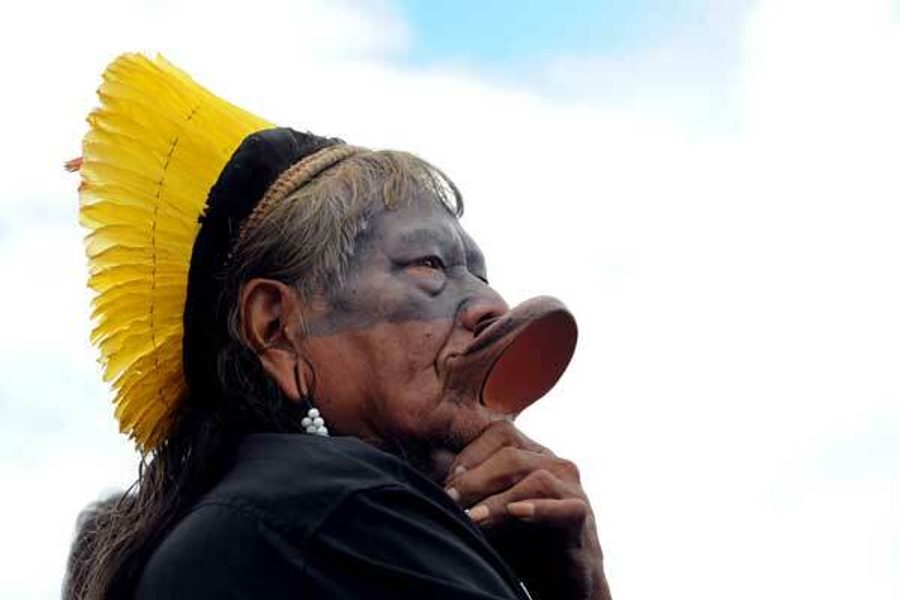Brazil’s Dam Shame
Construction of the giant Belo Monte dam is now underway in the Amazon. But the movement against it continues.
Gabriel Schwartzman

After more than 30 years of international and national opposition to building a massive Amazonian dam, Brazil’s environmental licensing agency gave final approval on June 1 to what could become the world’s third-largest hydroelectric site. But the fight to protect the Amazon is not over.
The dam had been held up for decades by the fierce resistance of Amazonian peoples, including indigenous groups, small farmers and river dwellers. The movement against the Belo Monte dam, based in the frontier city of Altamira, Parà, had won support from radical clergy, national nonprofits and international organizations such as Amazon Watch and International Rivers.
But despite intensifying opposition – including indigenous encampments in the capital city of Brasilia, numerous legal disputes and the Inter-American Commission on Human Rights’ call to suspend the project – the government has said construction on the project, estimated to cost between $4 and $11 billion, can begin. Norte Energia, the consortium in charge of building the dam on the Xingu River, a tributary of the Amazon River, has since begun readying a massive construction site.
With two federally recognized indigenous territories directly downstream, tribes such as the Juruna and the Arara will lose fishing areas and boat transportation as the river dries. Upstream, permanent flooding will bring heightened malaria and destroy floodplain ecologies culturally critical to river peoples, indigenous groups and city dwellers alike, according to the Brazilian environmental group Instituto Socioambiental. “If they kill our river, they kill us,” says Sheyla Juruna, an indigenous leader.
Ironically, it was a left-leaning government that pushed the project past the protesters. The Workers’ Party, first under Lula da Silva and now Dilma Rousseff, has consistently prioritized big business and industrial development in the Amazon, with plans to route Belo Monte’s 11,200 megawatts to industrial needs in southern Brazil. In a country that gets 80 percent of its electricity from hydropower, officials say the dam is part of a strategy to keep growing a clean Brazilian economy. Activists don’t dispute the need for clean energy, but they say expanding capacity on existing dams would be just as effective – and wouldn’t destroy new areas of the Amazon.
Regional activists like Moisès da Costa Ribeiro, an organizer with the Dam Affected Peoples Movement in Altamira, are bitter and unsurprised that the dam project is moving forward. “This is typical of the way the government treats Amazonia; Belo Monte is basically a kickback to the construction companies for help in the elections,” Ribeiro says.
The Norte Energia consortium, comprised of government-owned power companies and an assortment of privately held firms, has been working hard to undercut the opposition movement. Understanding the power of the indigenous voice in Brazilian politics, Norte Energia has given tens of thousands of dollars to indigenous groups in the region during the last three years, say Marcelo Salazar of Instituto Socioambiental and Ruy Sposati of Xingu Vivo. The same week Norte Energia received construction licensing from the government, the money dried up, triggering renewed indigenous opposition.
Vocal opposition to Belo Monte has yielded some results over the years. The government required Norte Energia to spend $600 million on 103 mitigating measures building the dam; these ranged from protecting turtle habitats to renovating education, health and water infrastructure in the region. Yet only three of the measures are completed as construction begins, Sposati says.
It won’t be easy to keep Norte Energia accountable. In Altamira, where many slum dwellers will lose their stilt houses, no one has heard from Norte Energia about promised support for relocation. “I bet you that at least 30 percent of us won’t get a centavo because they will ask for proper paperwork, and who has that?” railed Elias da Silva Santos, a pushcart vendor whose house will flood.
The power of the decades-long Belo Monte opposition movement should not be discounted. Xingu Forever Alive Movement Coordinator Antonia Melo, who has been organizing against the dam for decades, refuses to submit to Norte Energia. “This dam will not be built,” she declared in July, saying plans for direct action are in the works.
The new frontier of the movement, meanwhile, is insisting on implementation of mitigating measures. “If they did all the things they say they will, this area would have virtually no problems,” Salazar says. “Our fight is far from over.”

I hope you found this article important. Before you leave, I want to ask you to consider supporting our work with a donation. In These Times needs readers like you to help sustain our mission. We don’t depend on—or want—corporate advertising or deep-pocketed billionaires to fund our journalism. We’re supported by you, the reader, so we can focus on covering the issues that matter most to the progressive movement without fear or compromise.
Our work isn’t hidden behind a paywall because of people like you who support our journalism. We want to keep it that way. If you value the work we do and the movements we cover, please consider donating to In These Times.





